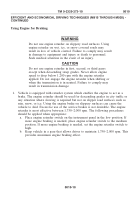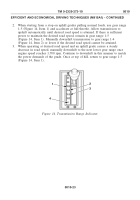TM-9-2320-273-10 - Page 181 of 452
OPTIMUM USE OF TACHOGRAPH - CONTINUED
NOTE
It is not necessary to operate the engine at maximum rpm for
good performance. The engine performs efficiently at low
and middle speed ranges and offers a definite fuel advantage
at these reduced speeds. Control rpm by tailoring engine
speed to the load requirements and desired road speed.
1. Use tachometer hand (Figure 12, Item 3) of tachograph (Figure 12, Item 1) to
monitor engine rpm in all gear ranges. When manually downshifting transmission
while tractor is moving, monitor tachometer hand (Figure 12, Item 3) to ensure
maximum 2,100 rpm engine speed is not exceeded.
2. Control engine rpm through proper use of accelerator and gear selection for load
requirements and desired road speed. For the M915A1 in normal driving
situations, use gear range 1-5 and allow automatic transmission to control gear
selection and engine speed.
3. Use speedometer hand (Figure 12, Item 2) of tachograph (Figure 12, Item 1) to
monitor tractor ground speed in miles per hour (mph). Ground speed and engine
speed can be compared to help determine gear selection for any given condition
(WP 0005).
4. Use odometer (Figure 12, Item 5) on tachograph (Figure 12, Item 1) to record
distance traveled. Fuel consumption in miles per gallon (mpg) is calculated by
dividing the number of miles traveled by the number of gallons consumed.
5. Use clock hands (Figure 12, Item 4) on tachograph (Figure 12, Item 1) to estimate
destination time based on miles per hour (mph). For example, if traveling at a
ground speed of 60 mph, it will take one minute to travel one mile.
END OF TASK
Figure 12. Tachograph.
M915 THROUGH M920
M915A1
1
2
3
4
5
1
3
2
5
4
TM 9-2320-273-10
0010
0010-15
Back to Top




















